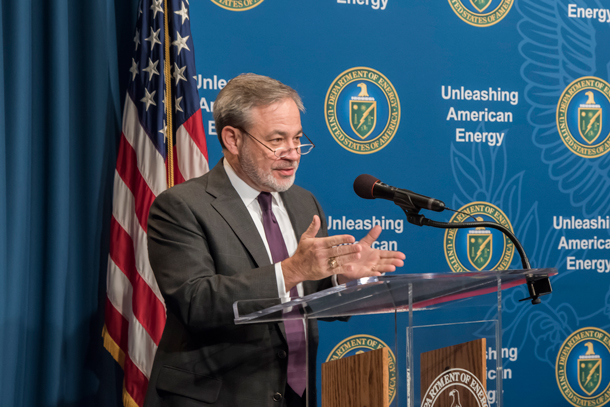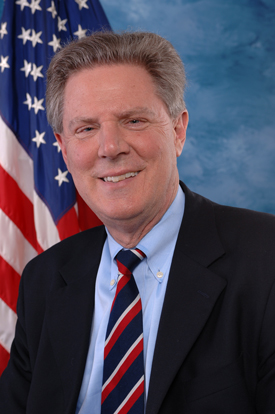Trump Stalls Clean Energy Loans
Air Date: Week of May 15, 2020

The solar energy industry is one of the fastest growing industries in the United States. (Photo: Naturalflow, Flickr, CC BY-SA 2.0)
Low-interest loans for clean energy could help boost the distressed economy by creating jobs, but $43 billion in loans for clean energy innovators that was set aside by the Obama Administration has barely been touched. Representative Frank Pallone Jr. (D-NJ), Chair of the House Committee on Energy and Commerce, joins Host Steve Curwood to explain the holdup and how the Administration is missing an opportunity to help the jobless.
Transcript
CURWOOD: From PRX and the Jennifer and Ted Stanley Studios at the University of Massachusetts Boston, this is Living on Earth. I’m Steve Curwood.
Congress and President Trump have enacted a number of measures to help prop up the economy while the coronavirus pandemic keeps millions of Americans isolated at home. Front and center is the CARES Act totaling trillions of dollars for big and small organizations as well as individuals. Months later the money has yet to arrive for many businesses and households. But the wait has been even longer for clean energy innovators who have waited for years to tap into a $43 billion low-interest loan fund that Congress and the president approved back in 2016, though it was a different president. Here to explain the holdup is Democratic Representative Frank Pallone Jr. of New Jersey, Chair of the House Committee on Energy and Commerce. Congressman Pallone, welcome back to Living on Earth!
PALLONE: Thank you, Steve.
CURWOOD: So there's this perhaps $43 billion in low-interest government loans for clean energy projects, that apparently has just been sitting around waiting to be disbursed by the Trump administration. How long has this been going on? Where's it supposed to go?
PALLONE: Well, they haven't done much, if anything, with this loan program. I mean, during the previous administration, under Obama, a lot of loans went out. And the return on investment was great. It was very successful, for the most part. I think that it's probably the case that the first Energy Secretary, Perry, was not, you know, too favorable to the program. So, we're hoping that the new Energy Secretary, Brouillette, is more favorably disposed and we're talking to him about it. But it's a real opportunity with money that's already available to really stimulate the economy and do innovative energy projects that you know, would create jobs and also be helpful for the environment.
CURWOOD: Well, I was gonna say that clean energy tech jobs have been some of the fastest growing jobs in the US for a number of years now. In your view, just how could clean energy loans help the country's economy in the face of this pandemic with so many folks who are unemployed?

Clean energy advocates hope that the new US Secretary of Energy, Dan Brouillette, will be more amenable to disbursing the clean energy loan money than his predecessor, Rick Perry. (Photo: National Nuclear Security Administration, Flickr, CC BY-ND 2.0)
PALLONE: Well, I mean, you mentioned that the US clean energy sector provides more than 3 million jobs, you know, that are both energy clean, but also energy efficient. And the whole purpose of this program, Steve, is to look into innovation. In other words, you know, what kinds of projects are innovative and would utilize either existing technologies in innovative ways or be the first of the kind in a geographic region? We know that these types of things create a lot of jobs, and I think I have some statistic here that says that for the loans that went out, mostly prior to the Trump administration, less than 3% of the projects defaulted on their loans, so it has a real good record of success and supporting both businesses and jobs and of course right now because we've got, what, 30 million people filed for unemployment in the last few weeks or months because of COVID-19. I mean, something like this would be really important now in terms of creating jobs at such a high unemployment rate out there from the virus.
CURWOOD: Now, as the chair of the House Committee on Energy and Commerce, what are the moves that you have now to address this issue?
PALLONE: Well, I mean, there's two things. One is to try to convince the Secretary, as I said, the new secretary Brouillette, to actually, you know, push this out. And then the second thing is to make some structural changes in the program. And the Energy and Commerce Committee that I chair has most of the jurisdiction that relates to climate change or climate action. And so we put forward a proposal called the CLEAN Future Act that has a number of initiatives to try to address climate change and make us carbon neutral by 2050. And so in that we have some structural changes to this energy program, this loan program that we're talking about today, that would, I think, improve the situation. Three things. Right now the Department of Energy has high fees that are a barrier for entry into this program. So what we do in our CLEAN Future Act is reduce expenses so that the program is accessible to more applicants. And then the second thing we have is trying to expand eligibility. This loan program has this innovation threshold, that the project has to utilize existing technology in innovative ways and be the first of its kind. So we're trying to provide more flexibility. So this idea, first of the kind isn't just like the only one nationally but maybe first of the kind in the southeast or first of the kind in New England, you know, that type of thing. And then the last thing is to have some kind of reforms for advanced technology vehicles, to expand eligibility because you know, a lot of these loans were for cars or heavy duty vehicles, you know that would refocus the program on vehicles with lower or zero carbon emissions, because that seems to be where a lot of these technological innovations are, that would be eligible for the program. If the Secretary was just willing to push out a lot of these loans, I think we could still do it without these structural changes that I'd like to see. But when we do a stimulus package, and hopefully we do a stimulus package in the next few months, we would like to see these changes that I mentioned to the program be incorporated.

Frank Pallone Jr. has served as US Representative as a Democrat for New Jersey’s 6th congressional district since 1988. He is the Chair of the House Energy and Commerce Committee. (Photo: US House of Representatives, Wikimedia Commons, Public Domain)
CURWOOD: Now, some might say that these loans are going unused as a result of a partisan decision to promote the fossil fuel industry over the clean energy sector. How do you respond to that?
PALLONE: I mean, I think that's true, but I can't, you know, verify it, but I mean, as you know, the Trump administration has been much more fossil fuel oriented. They haven't really been advocates for clean energy proposals, or, you know, some of these innovative manufacturing projects for cars or trucks as well. If anything, they've been moving in the opposite direction and, you know, loosening fuel efficiency requirements, and encouraging more fossil fuels, and doing even more of that now during the COVID emergency. I would probably say you're right. But my argument to the Secretary is, look, let's do everything, right? And I'm not saying they should only do clean energy technology, as opposed to fossil fuel. But this is a program that's out there and that we think can stimulate jobs. So put aside your opposition in this environment because we need to create jobs, and don't look at it ideologically. I mean, that may be difficult. But you know, that's what I kind of do with everything right now.
CURWOOD: So, here we are in May, six months away from a national election, if the wind blows in the direction of the Democrats, what are your hopes for next year as Chair of the Committee on Energy and Commerce in the House?
PALLONE: Well, we have two things. One is to enact the CLEAN Future Act into law so that we move towards this carbon neutral goal of 2050 and reach that goal over the next few decades. And then, of course, a major infrastructure program that's oriented towards energy efficiency and clean energy. And that would include upgrading the energy grid, creating a national program for electric vehicles, and trying to do more to encourage clean energy both through incentive grants as well as tax policy. You know, there's a lot that can be done, and hopefully we have a democratic president. They're going to be much more oriented towards meeting these climate goals and putting in place programs both with you know, major infrastructure initiatives and other grants and financial incentives to achieve that. That would be the goal.
CURWOOD: Congressman Pallone is a Democrat who represents the Sixth District of New Jersey and Chairs the Committee on Energy and Commerce. Thanks so much for taking time with us today.
PALLONE: All right. Thank you, Steve. Take care.
Links
The New York Times | “Billions in Clean Energy Loans Go Unused as Coronavirus Ravages Economy”
Listen to our previous interview with Rep. Pallone (D-NJ) about the Climate Action Now bill here
Living on Earth wants to hear from you!
Living on Earth
62 Calef Highway, Suite 212
Lee, NH 03861
Telephone: 617-287-4121
E-mail: comments@loe.org
Newsletter [Click here]
Donate to Living on Earth!
Living on Earth is an independent media program and relies entirely on contributions from listeners and institutions supporting public service. Please donate now to preserve an independent environmental voice.
NewsletterLiving on Earth offers a weekly delivery of the show's rundown to your mailbox. Sign up for our newsletter today!
 Sailors For The Sea: Be the change you want to sea.
Sailors For The Sea: Be the change you want to sea.
 The Grantham Foundation for the Protection of the Environment: Committed to protecting and improving the health of the global environment.
The Grantham Foundation for the Protection of the Environment: Committed to protecting and improving the health of the global environment.
 Contribute to Living on Earth and receive, as our gift to you, an archival print of one of Mark Seth Lender's extraordinary wildlife photographs. Follow the link to see Mark's current collection of photographs.
Contribute to Living on Earth and receive, as our gift to you, an archival print of one of Mark Seth Lender's extraordinary wildlife photographs. Follow the link to see Mark's current collection of photographs.
 Buy a signed copy of Mark Seth Lender's book Smeagull the Seagull & support Living on Earth
Buy a signed copy of Mark Seth Lender's book Smeagull the Seagull & support Living on Earth

